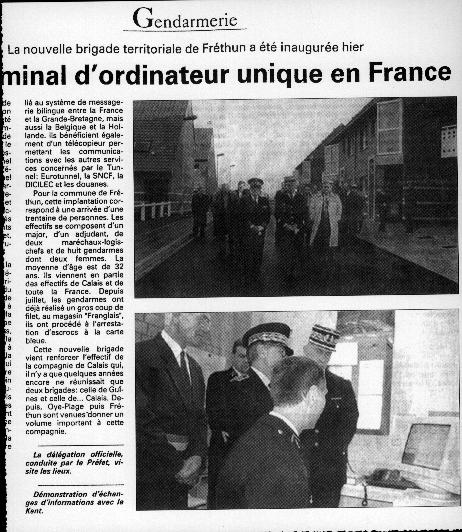

In 1993 a dedicated communications network was designed, built and funded by Prolingua Limited and, with the help of the European Liaison Unit of the Kent County Constabulary, installed between a small number of operational locations to assist with real time cross-border enquiries and major incidents. Although originally installed for research purposes, this early version of LinguaNet soon proved an effective, reliable and secure means of transmitting operational cross-channel messages. As such, the system attracted the attention of other police forces in the United Kingdom, Northern France, Flanders and the Netherlands with ferry links between Britain and Continental Europe.
The system rapidly developed from a simple bi-national "end-to-end" messaging link to an operational communications network between police agencies in four European countries. It now connects fifteen police forces in five European countries as well as the emergency control centres at either end of the Channel Tunnel. This prototype now provides a continuous stream of genuine individual messages and complete dialogues in several languages for the language analysis used in the system build. It also serves an urgent operational requirement for cross border collaboration as witnessed by the resolution of several serious offences. The police services on the network meet regularly as a user group and provide continuous commentary regarding operation of the system. They contribute helpful criticism of new facilities offered by the developers and suggestions for entirely new facilities prompted by their operational experiences.
The prototype is effectively divided into two layers: the user interface and translation software, and the electronic mail system. The top layer was written by Prolingua Ltd while the lower layer uses standard Unix components. This split was deliberately made to allow for the use of alternative mail transport systems.
The top layer is a single program which contains the user interface and the translation software. It is written in standard ML, and uses the Poly / ML system written by Dr D.C.J. Matthews at the University of Cambridge with the X-Windows Motif interface developed by Abstract Hardware Ltd. this layer interfaces to the electronic mail system by running Unix commands.
The advanced LinguaNet software program is run on standard IBM-compatible PCs with commercially available modems and printers. To operate, the system requires a standard analogue telephone line with the ability to send and receive calls from the international telephone network. This can be achieved by use of a dedicated line or via a dedicated extension serviced by an automatic switchboard. The structure and components of the system will be changed considerably during the present system build.
From the outset, the aim of the development of the system has been to produce a system which is simple to use and install. The software is already configured to run English, French, Dutch/Flemish, Danish, Spanish and German versions.
At present, the system enables its users to assemble templated messages concerning matters of common concern such as missing or wanted persons, vehicles and credit cards, and composite messages containing a number of such segments. These largely text-based messages are translated between all the languages presently available on the system. Free text segments without translation are at present permitted, but the quantity of these will diminish as more powerful grammars, interface improvements and additional media such as pictures, fingerprints and voice samples are introduced and integrated. All messages may be encrypted prior to transmission.
The large English/ French police and emergency service operational lexicons produced during the PoliceSpeak and Intacom projects are available on the system already to assist officers in decoding (and creating) free text messages which are outside the present scope of the automatic translation modules. These lexicons may provide the organisational structure for the creation and installation of all other European language lexicons for the police and emergency services.
System directories are being created to provide multilingual on-line access to support data such as emergency plans, contact points for certain types of enquiries, details of locations, responsibilities, operational strengths and jurisdictions of units connected to the net.
The locations of the LinguaNet terminals active at the start of the consortium-based EC Framework 4 funded project in 1995 are shown on the map. Locations which have become operational since that date or which are presently the subject of negotiation are shown on a further map. This will be updated at regular intervals during the lifetime of the project.